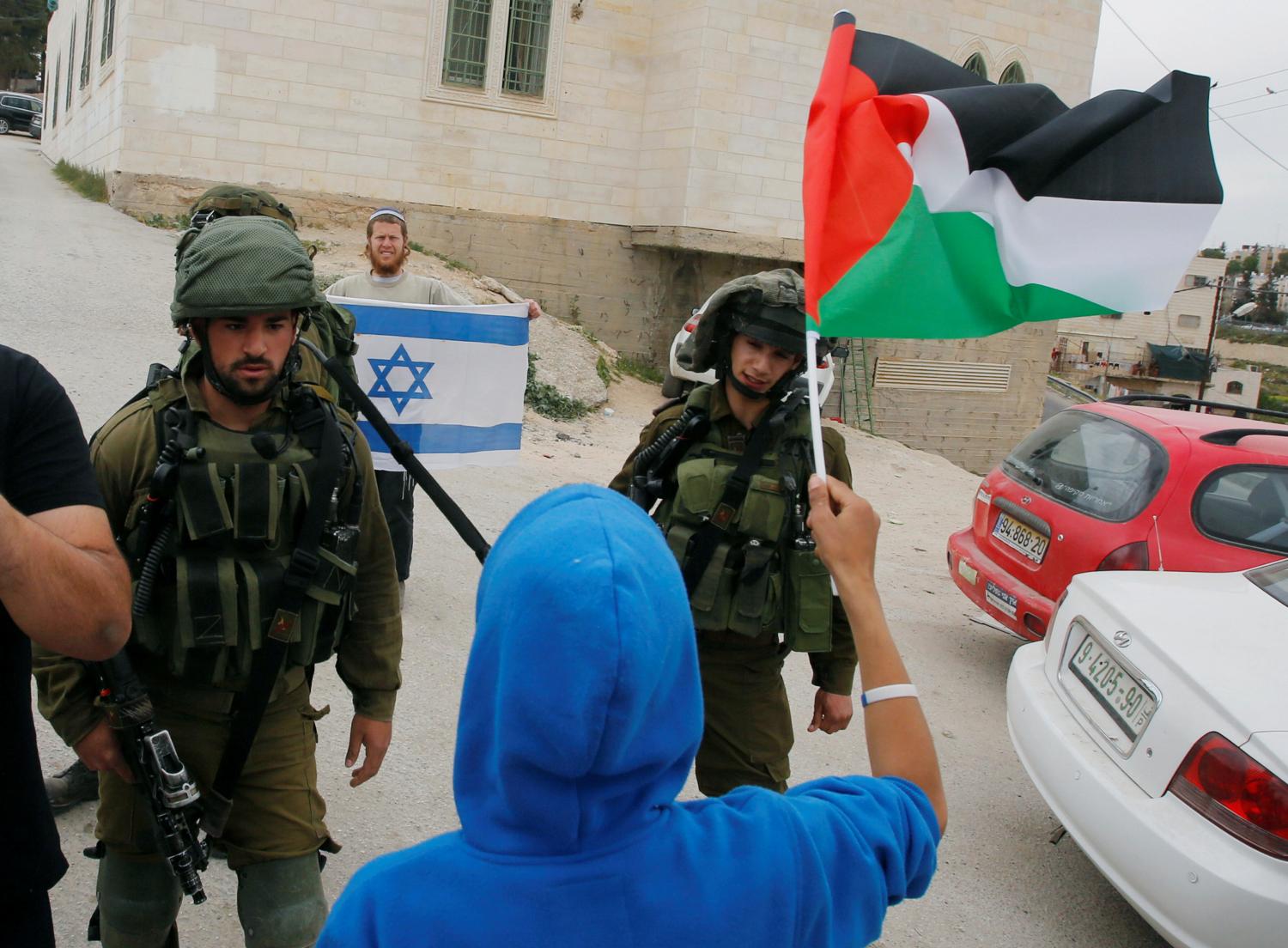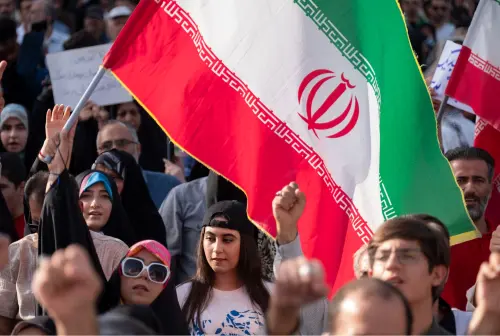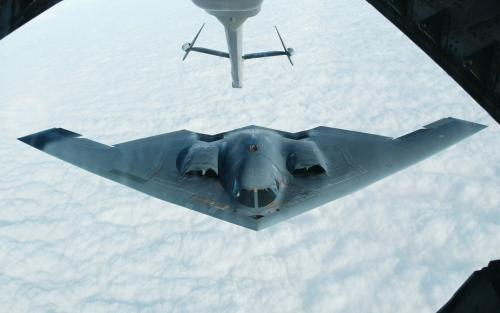In their framing posts for this series, Khaled Elgindy and Natan Sachs argue that although the peace process is currently deadlocked or even dead, there are potential paths forward that preserve the end goal of resolving the Israeli-Palestinian conflict through a two-state solution. While their policy prescriptions vary considerably, they have one thing in common: a focus on executive-level decision-making as both the reason for the current intractability of the conflict, and as the best hope for resolving it. I agree that this conflict will not be solved without bold and courageous steps by both Israeli and Palestinian leaders. However, in the absence of an active peace process, Israelis, Palestinians, and the international community should prioritize addressing the growing hatred, mistrust, and violence both between and within Israeli and Palestinian society.

Photo courtesy of REUTERS/Abed Omar Qusini
Fear not the third intifada
One of the worst outcomes of last summer’s Gaza war and the horrific events preceding it is a marked increase in sporadic violent acts by civilians directed against civilians. These incidents have ranged from a car intentionally ramming into a Jerusalem light rail station, to a stabbing that wounded a dozen on a Tel Aviv bus, to an arson attack that killed three—including an 18-month-old—in the West Bank village of Duma.
Many worry that the current pattern of violence is a precursor to a much larger, more organized confrontation between Palestinians and Israeli security forces, aka a “third Intifada.” Too often, observers of this conflict fall prey to what I call “third Intifada syndrome.” I suffered from this ailment myself several years ago as a new officer in the State Department’s Office of Israel and Palestinian Affairs. Everywhere I looked, I saw indications that the third intifada was just about to break out. Today, however, I agree with Khaled and with Neri Zilber that an event of this magnitude requires the cooperation of the Palestinian leadership, which, despite its frustration with the status quo, is not interested in a violent confrontation with the Israel Defense Forces.
It is not another intifada we should be worried about, but rather the simmering tension between the Israeli and Palestinian publics that is fueled by government policies and rhetoric on both sides and by a lack of understanding of the other side that characterizes this generation. Natan is right to point out that any resumption of large-scale violence would cause “immediate devastation and long-term damage.” However, even the level of small-scale violence that has been ongoing intermittently since last summer has the potential not only to push moderate Israelis and Palestinians into the arms of their respective extremist groups, but also to permanently divide the two societies, rendering impossible the most basic level of coexistence necessary for the implementation of any successfully negotiated settlement.

Photo courtesy of REUTERS/Mussa Qawasma
This is why it is imperative that, in the short term, the Israeli and Palestinian leaderships, civil society actors, and the international community shift their emphasis from a return to the negotiating table and toward healing the deep divide between the societies that I consider as the greatest obstacle to a peaceful settlement of the Israeli-Palestinian conflict. Certainly, all parties should continue to work towards a political resolution of the conflict in the long term, but in the absence of an active peace process, ignoring the growing divide between and Israelis and Palestinians will only make a political solution that much harder to achieve down the road. Both Khaled and Natan are right to point out the crucial nature of Israeli-Palestinian security cooperation in keeping violence at bay; however, even the most professional and successful security services cannot undo the decades of hate and mistrust among the populations. Bridging these divides will require the United States and other donor governments to invest much more heavily in conflict management at the civil society level.
President Obama said it best during his speech in Jerusalem in 2013: “peace begins not just in the plans of the leaders, but in the hearts of people. Not just in some carefully designed process, but in the daily connections—that sense of empathy that takes place among those who live together in this land and in this sacred city of Jerusalem…Political leaders will never take risks if the people do not push them to take some risks.”

Photo courtesy of REUTERS/Jason Reed
Put your own houses in order first
While it is clear that the division between Israelis and Palestinians is vast and growing, healing that divide first requires increased attention to intra-societal conflict to bring both Israelis and Palestinians back from the brink of further violent conflict. Israeli and Palestinian society each suffers from two trends, both of which are harmful for peace. First, we see a growing intra-societal divide: religious-secular, in the case of Israelis; physical and political, between Gaza, the West Bank, and the diaspora—as well as between Fatah and Hamas, in the case of Palestinians. Second, there is an increase in intolerance and xenophobia at both the societal and state levels.
Much has already been written about intra-Palestinian divisions. Thus, I will focus here on the growing division within Israeli society, an issue which has largely been ignored by policymakers and pundits. Religiously, the ultra-Orthodox population is growing (9.1 percent in 2013 according to the Israeli Central Bureau of Statistics, up from 6.4 percent in 2003) while the secular population is shrinking, particularly among young Israelis (35.2 percent of 20 to 24 year-olds identified as secular in 2013, compared with 45.8 percent in 2003).
Politically, Prime Minister Benjamin Netanyahu’s precariously narrow coalition has pushed him and his supporters to pursue policies (see, for example, here, here, andhere) that not only alienate the left, but also threaten to erode Israel’s democracy. While none of these policy proposals have become law, the fact that they were suggested at all is a troubling sign. Most concerning is the politicization of the Israeli education system under Education Minister Naftali Bennett, a staunchly right-wing religious politician who supports the settlement movement and who opposes the creation of a Palestinian state. When Israeli youth are only taught a one-sided narrative of their country’s history, when Palestinians can be punished for commemorating the Nakba, or when the Education Ministry turns a blind eye to unregulated schools, as reported by Ha’aretz, Israeli children are certain to grow up ignorant of their neighbors, as well as of the Palestinian citizens of Israel, and, consequently, these individuals will be more easily persuaded to hate. In addition to current programs in place which seek to promote cross-societal understanding, the Israeli government should develop a compulsory comprehensive curriculum devoted to tolerance and diversity, beginning at the earliest grades and focused on both understanding the Palestinian narrative as well as the multiple Jewish narratives, from the secular to the settler.

Photo courtesy of REUTERS/Ronen Zvulun
Notably, in an editorial in The New York Times in August, Bennett himself made an impassioned plea to address the rise of Jewish terrorism in Israel and the West Bank and argued that tolerance needs to be taught in Israeli schools: “We need to teach more tolerance, respect and appreciation of all people. This can be accomplished by learning more about Arabs, their culture and history and by teaching Arabic to Jewish students.” This would be a welcome first step, but I question what “history” and “culture” Minister Bennett would advocate in a revised Israeli curriculum. Additionally, as the current strike in Christian schools in Israel over unequal funding shows, inequality in the education system is a deeply rooted problem that will not be solved by lessons in tolerance alone.
In addition to promoting tolerance within the education system, Israeli leaders must address Jewish terrorism with the same degree of seriousness as they grant the issue of Palestinian terrorism. Israeli officials have been quick to condemn attacks carried out by Jewish Israelis, even designating the perpetrators of these acts as “illegal associations” in August 2013 and, more recently, approving the use of administrative detention against Jewish extremists. Even so, indictments have been few and punishments have been relatively weak, as noted in the State Department’s 2014 Report on Terrorism and documented by human rights nongovernmental organizations (NGOs), such as B’Tselem.
Furthermore, Netanyahu must be steadfast in maintaining the status quo on the Temple Mount/Haram al-Sharif. While the site is victim to violent clashes every year around the Jewish High Holy Days, this year has so far witnessed a level of violence between Palestinian worshippers and demonstrators and Israeli security forces that has led to public calls for restraint from the White House, the U.N. special coordinator, and the EU, among others, and a particularly harsh warning from King Abdullah of Jordan (which administers the site) that “any more provocations in Jerusalem, will affect the relationship between Jordan and Israel; and Jordan will have no choice, but to take action.”
Netanyahu is under tremendous pressure from his government, multiple members of which have been vocal about their desire to overturn existing policy and allow Jewish prayer on the Temple Mount/Haram al-Sharif compound, likely regulated by some sort of time-and space-sharing agreement similar to highly controversial arrangements in place in Hebron. Netanyahu must make clear privately to his own cabinet, and publicly to the Israeli and Palestinian people (and the international community), that he will not, under any circumstance, allow for a shift in the status quo at the site.
The international community also has an important role to play in healing the intra-societal divide and promoting tolerance and diversity. First, donors should prioritize intra-national reconciliation programs over joint Israeli-Palestinian programs in the short term. Too often, joint programming is thwarted by the anti-normalization campaign (a largely Palestinian movement aimed at preventing joint Israeli-Palestinian civil society activities, for fear of “normalizing” the occupation) or other forms of bullying, making NGOs reluctant to participate in reconciliation programming and making donors skittish about supporting the same. In today’s climate, there is both a dire need and a window of opportunity for increased assistance to programs that bring together Israelis from across the political spectrum and, separately, Palestinians from across the political spectrum.
In the absence of a formal peace process, U.S. officials (whether representatives of the executive branch or congressional delegations) should increase their engagement with Israeli and Palestinian civil society on the ground. This engagement should include efforts to reach out to both groups and individuals within the moderate camps as well as influencers within more extremist communities, including supporters of Hamas and radical settler groups. While I am not advocating that the U.S. government change its no-contact policy in regard to Hamas, I do believe all would be better served by making a concerted effort to engage with those influential individuals who are squarely outside the pro-peace camp. Doing so would develop a deeper understanding of each side’s positions and would strongly advocate for a peaceful resolution to the conflict in the long term.
But don’t give up on coexistence
Although in the short term donors should focus their efforts on intra-societal initiatives—as the time is not ripe to force people-to-people interaction between Israelis and Palestinians, in the long term—it is essential to also nurture cross-cultural coexistence efforts to prepare both societies for an eventual two-state scenario.
One of the consequences of the post-Oslo period has been the near total separation of Israelis and Palestinians. While a generation ago most Israelis and Palestinians had at least minimal contact with individuals from the other side, today a combination of Israel’s security policies (the Gaza blockade, the separation barrier) and Palestinian anti-normalization efforts have virtually erased any contact between the two. This lack of contact breeds ignorance and misunderstanding at best and horrific violence at worst.

Photo courtesy of REUTERS/Mohamad Torokman
Despite this bleak picture, there are a handful of Israeli, Palestinian, and international NGOs focused on improving the quality and quantity of contact between Israelis and Palestinians. These organizations have continued to carry out their activities in even the most difficult circumstances. The most successful of these organizations focus on concrete problems and common interests such as protecting the environment, sports and recreation, or vocational training (rather than overt peace-building). As one recent survey finds, practical, mutually beneficial interaction between the two populations breeds more moderate attitudes.
Thus, the United States and other donors should continue to support these types of groups through vehicles like USAID’s $10-million People-to-People Reconciliation Fund. But such support is insufficient to address the deep intra- and inter-societal divides. Donors should therefore increase their spending on and attention to civil society, recognizing that a combination of intra-societal and inter-societal reconciliation will be necessary to resolve the conflict in the long-term.
As U.S. Consul General in Jerusalem Michael Ratney so eloquently said upon his departure from that post, in addition to negotiations, part of the answer to solving this conflict “lies in knowing each other, and respecting each other, as people, in recognizing our common humanity, in accepting that as people, as human beings, not as political symbols, there’s an attachment to this land that sometimes transcends reason, that cuts to the heart of faith and identity and history…Only when all those with a claim to this land recognize and respect the faith, and the identity, and the history of the other, will we all know that we’re finally on the road to something better.”
The Brookings Institution is committed to quality, independence, and impact.
We are supported by a diverse array of funders. In line with our values and policies, each Brookings publication represents the sole views of its author(s).





Commentary
Israeli-Palestinian futures: Don’t forget about the people
September 28, 2015